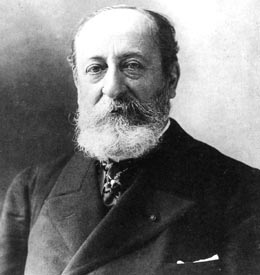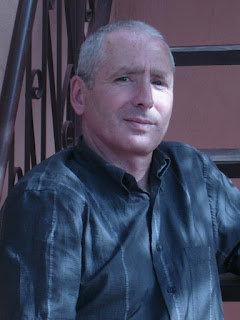Composer: Camille Saint-Saëns
CD1:
- Le Deluge, Op. 45: Prelude
- Serenade, Op. 15
- Hymne de la fete de pacques
- Album de Gauloises: No. 16 Improvisation
- Chant du Soir, after Schumann Op. 85 No. 12
- Improvisation sur la Beethoven-cantata de Liszt
- Bagatelle I
- Bagatelle II
- Berceuse, Op. 105
- Paraphrase sur Gallia de Gounod
CD2:
- Fantasie en re majeur ecrite par Luis Milan de Valence
- Fantasie en sol mineur ecrite par Luis Milan de Valence
- Douze transcriptions pour piano: No. 1 Ouverture due 29e cantate, BWV 29
- Douze transcriptions pour piano: No. 2 Adagio de la 3e cantate, BWV 3
- Douze transcriptions pour piano: No. 3 Andantino de la 8e cantate, BWV 8
- Douze transcriptions pour piano: No. 4 Bourree de la 1e Partita, BWV 1002
- Douze transcriptions pour piano: No. 5 Andante de la 2e sonate de violon, BWV 1003
- Douze transcriptions pour piano: No. 6 Presto de la 35e cantate, BWV 35
- Douze transcriptions pour piano: No. 7 Introduction et Air de la 15e cantate, BWV 15
- Douze transcriptions pour piano: No. 8 Fugue de la 3e sonate de violon, BWV 1005
- Douze transcriptions pour piano: No. 9a Largo de la 3e sonate de violin, BWV 1005
- Douze transcriptions pour piano: Recitatif et Air de la 30e cantate, BWV 30
- Douze transcriptions pour piano: No. 10 Gavotte de la 3e Partita, BWV 1006
- Douze transcriptions pour piano: No. 11 Air de la 36e cantate, BWV 36
- Douze transcriptions pour piano: No. 12 Choeur de la 30e cantate, BWV 30
Antony Gray, piano
Date: 2022
Label: Divine Art
----------------------------------------------------------------------------
I was impressed with Volume one of Antony Gray's exploration of the lesser known original works and transcriptions of Camille Saint-Saëns (review) and have been looking forward to the treasures on this set. Nadejda Vlaeva gave us an excellent recording of the Bach transcriptions (Hyperion CDA67873 review) and the two more substantial items on disc one appeared on volume 5 of Geoffrey Burleson's set (Grand Piano GP626 review) along with the 2 bagatelles but there remain a good selection of works that have not previously been recorded in these versions.
The biblical oratorio La Déluge was rated one of Saint-Saëns' best works at one time but it is generally only the prélude recorded here that is heard nowadays. This transcription, basically lifted from the vocal score, is not credited though it is possible that it is by the composer. It opens with a rather archaic introduction and fugue before the theme of the second part begins, scored for solo violin and strings in the original. The Sérénade was originally scored for piano, harmonium, violin and viola and was successful enough that it appeared in several different versions, including one for two mandolins and piano while Sir Thomas Beecham conducted Saint-Saëns' orchestral version in 1913. With its undulating accompaniment, more complex at its return, it becomes an Italianate serenade; gentle arabesques adorn the central section and like the Déluge extract it is a faithful transcription of the original rather than a reworked paraphrase. The transcription of Schumann's Chant du soir falls into this category as well, adapted from a previous arrangement for piano duet but his transcription of the Easter Hymn from Act 2 of Berlioz's Damnation of Faust is a little more adventurous, filling out the orchestral parts and incorporating the chorus in much the same way Liszt did in his later Wagner paraphrases.
Perhaps my favourite discovery among this collection is the Improvisation written for inclusion in an Album du Gaulois in 1885; I will be checking out the available music from this album that also includes works by Liszt, Clara Schumann and Tschaikowsky as well as lesser known names such as Marie Jaëll and Raoul Pugno. Saint-Saëns' jaunty and lilting contribution experiments with harmony, manoeuvring from enigmatic layered chords to conventional cadences almost throughout, hardly what I would have expected from the French composer. It is not known if the two Bagatelles of 1858 were originally intended to join the op.3 Bagatelles or if Saint-Saëns even intended them as bagatelles at all; the name was added by his secretary and biographer Jean Bonnerot; the first opens with a simple melody with chordal textures before the chords break into arpeggios for a brief but more harmonically complex section and the opening returns. The second is scherzo-like with echoes of a bucolic hunting scene. The Berceuse, written for the birth of one of Saint-Saëns' friend's daughter, was originally for piano duet; French virtuoso Isidor Philipp produced the solo piano version we hear of this gentle little lullaby.
Two larger scale cantata transcriptions complete disc one; the Improvisation sur la Beethoven-Cantata by Liszt and Paraphrase sur Gallia after Gounod's now little known work. The improvisation is a largely meditative work though full of the grand gestures that Liszt himself was so fond of, tremolandi and octaves and it is remarkably faithful to his style. Liszt wrote the Beethoven-Cantata for the dedication of the Beethoven monument in Bonn in 1845 but it was a later revised edition for Beethoven's centenary in 1870 that Saint-Saëns heard and based this work on. The opening develops the andante cantabile from Beethoven's Archduke trio and the main theme from the opening movement of the Eroica symphony also makes an appearance. Gallia is a four movement work written for the London International Exhibition of 1871 and was inspired by the tribulations of the Franco-Prussian war; it must have impressed Saint-Saëns who produced this quite Lisztian paraphrase soon after. The central section recalls the tumult of battle while the outer sections are more lyrical, the final part a fervent version of the final chorus Jerusalem! Jerusalem! In both of these works, and indeed in much of this music generally, Anthony Gray is quite expansive in his playing so that the Improvisation sur la Beethoven-Cantata takes 16 minutes as opposed to Burleson's 12 and Gallia is similar; Gray 12:34 Burleson 8:54. This is not really an issue here and as I said in my review of volume one (Divine Art DDA21235) Gray's playing is neither dull nor cautious. Some may prefer the slightly more flowing playing of Burleson but I think pianophiles may generally want both performances for completeness in any case.
Saint-Saëns made 13 transcriptions from the cantatas and violin works of Johann Sebastian Bach. The Bach revival had begun with the advocacy of Mendelssohn and others and already works were appearing in transcription; the arrangements of the organ works by Liszt came from the 1840s and between the two sets that Saint-Saëns wrote, in1861 and 1873, Liszt pupil Carl Tausig arranged several of the chorale preludes. The cantatas had been gradually published at the time and Saint-Saëns made his selection from those as well as movements from the violin sonatas and partitas including the transcription of the Bourrée from the first Partita that is still occasionally heard. Gray plays them all well but I have to say that Vlaeva has the edge for me especially in the slower items; the opening of the Andante from the second violin sonata is the most obvious case in point where Gray sounds somewhat stiff in the balance of melody and accompaniment compared to the wonderful richness of Vlaeva's phrasing though Gray soon warms into the movement. I find Vlaeva's rhythmic impetus just a little more focussed as well but this is splitting hairs and I am happy to have both versions.
The final items to mention are two real rarities in the form of transcriptions of works by 16th Century Spanish composer Luis de Milan, or D. Luis Milan de Valence as the first edition would have it. Saint-Saëns edited works of early French music and evidently his wide ranging tastes led him to these works originally written for lute. He makes fine piano works out of them, recreating them respectfully in terms of the modern instrument without going to the grand extremes that Liszt did in his Miserere d'après Palestrina while still making the most of the sustaining features and range of the piano.
Once again Gray has opened up a treasure trove of fascinating rarities and little known arrangements that add quite considerably to the relatively modest amount of original piano works from this prolific composer and with his performances of conviction and presence this is well worth the outlay to explore.
-- Rob Challinor, MusicWeb International
----------------------------------------------------------------------------
Camille Saint-Saëns (9 October 1835 – 16 December 1921) was a French composer, organist, conductor and pianist. Saint-Saëns was a musical prodigy, making his concert debut at the age of ten. He was a successful freelance pianist and composer, in demand in Europe and the Americas. His best-known works include his concertos, his 3rd symphony, Danse macabre and The Carnival of the Animals. Saint-Saëns was enthusiastic for the most modern music of the day, although his own compositions were generally within a conventional classical tradition. Saint-Saëns' students included Gabriel Fauré.
http://en.wikipedia.org/wiki/Camille_Saint-Sa%C3%ABns***
Antony Gray is an Australian pianist who was born and educated in Victoria, Australia. He graduated from the Victorian College of Arts where he studied with Roy Shepherd and Stephen McIntyre. Gray continued his studies in London with Joyce Rathbone and Geoffrey Parsons on a scholarship. Since his time at College he has been a champion of many living and neglected composers. Gray is one of ABC Classics' most prolific recording artists, having recorded fourteen discs of solo piano music for the label, as well as featuring on a recital disc for KNS Classical and a number of other recording projects.
http://www.antony-gray.co.uk/
http://www.antony-gray.co.uk/
----------------------------------------------------------------------------
FLAC, tracks
Links in comment
Enjoy!



Choose one link, copy and paste it to your browser's address bar, wait a few seconds (you may need to click 'Continue' first), then click 'Free Access with Ads' / 'Get link'. Complete the steps / captchas if require.
ReplyDeleteIf you are asked to download or install anything, IGNORE, only download from file hosting site (mega.nz).
If MEGA shows 'Bandwidth Limit Exceeded' message, try to create a free account.
https://link-center.net/610926/saint-saens-piano-v2
or
https://uii.io/q2AAm4d
or
https://exe.io/d4vxwm
Rita Strohl; César Franck - Cello Sonatas (Sandra Lied Haga; Katya Apekisheva)
ReplyDeleteon May 09, 2023
El link no funciona, gracias
This one?
Deletehttps://musiqclassiq.blogspot.com/2023/05/rita-strohl-cesar-franck-cello-sonatas.html
The link seems good to me. Could you be more specific about your issue?